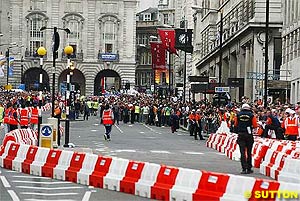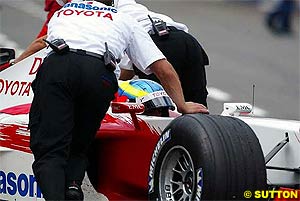Atlas F1 Magazine Writer
Fresh from the Formula One paddock
European summers. The season for long days and warm nights, sunny French Opens, washed-out Wimbledons, defeated Brits, three non-tobacco races on the trot, Nigel Mansell non-retirement statements. And Silver-Stoning. The script has been visited a thousand times in 15 years, and yet, two weeks before every race, the stoning starts.
Of course, there was a time when Silverstone circuit richly deserved every bit of criticism – but, then, so did they all. In 1995, for example, a 20-mile journey from M40 to Main Gates via a circuitous A43 to watch qualifying - rained upon, meaning cars either failed to venture out, or lapped so farcically slowly that the regulations were changed for the next season - took all of five hours. The journey out took longer.
But, the same year, in- and egress at Nurburgring and Hockenheim was no better; in fact, it was, according to some, way worse. So was it at Magny-Cours and Spa-Francorchamps. And, note: apart from Belgium, whose tobacco ban would come later, cigarette advertising could not be cited in mitigation at the French or German events.
In 1997 a trip from London to Silverstone (100 miles) on race day took all of five hours: 60 minutes to the M40/A43 junction; 240 for the last 20 miles or so. But, the following year, it took the same length to reach the 'Newburgring' – despite staying at the German town of Euskirchen, just 50 miles from the circuit.
Since then access to Silverstone has steadily improved, with the only real problem coming when the circuit was given – against its absolute wishes – an Easter Sunday fixture in 2000. Despite meteorologists warning against the date, citing 40-year records as proof that Easter Sunday was the wettest such day in the British year, Silverstone was given the date by the powers that were.
Of course that Grand Prix destroyed Silverstone's reputation, so much so that many ventured that the date had been wilfully allocated, pencilled in as part of a larger game plan. And, like the 'bad' girl on the block who got mislead into a 'dirty' weekend, the place's reputation has never recovered, despite efforts in all directions to repair the damage. The BRDC has taken knock after knock, attendances in subsequent years were cut to prevent repeats of gridlocks, alternate access roads were found (and, in some instances, leased from neighbouring farmers at substantial cost), park-n-ride schemes were initiated, and, last year, an under construction, four-lane A43 was make-shifted to allow weekend access.
Last year's London-Silverstone trip took 90 minutes, the return even less. The previous week's 20-odd kilometres from Nevers to Magny-Cours lasted longer, with local hotel rip-offs compounding the misery. That, though, was overlooked as the chauffeur of a certain influential gentleman - bearing the initials 'BCE' - got lost within Silverstone's grounds to re-spark the access and muddy field furore.
But, matters looked good for Silverstone 2004-and-beyond. Interpublic, which had gained the Grand Prix rights via purchase of listed Brands Hatch Leisure plc, which had gained its promoter's rights after paying way over the top in a bid to bring to the British Grand Prix to an unlicensed, under facilitated circuit in Kent with even worse access than Silverstone, wanted out of its BGP contract, and paid Bernie Ecclestone £93m for the privilege. It would also, it said, settle its outstanding lease with Silverstone Circuit's owner British Racing Drivers' Club – an agreement it had inherited when it took over BHL, which lacked planning permission to convert Brands Hatch's inaccessible, muddy fields into expensive inaccessible muddy fields.
But, no, it seems Ecclestone still had his knife in for Silverstone, or, more accurately, the BRDC, of which he is, believe it or not, a member. The Old Blazer and Windsor Knot organisation had, in the late nineties, built an imposing club house instead of tarring some muddy fields, and, despite the total value of the structure being somewhat less than a 12-bedroomed house in Knightsbridge, invoked the wrath of Ecclestone, who believed that those funds may have been better spent on pits or toilets. That the BRDC insists upon retaining the signage rights to Silverstone has not helped its cause, either.
So, the BRDC has done no right in the eyes of Formula One's commercial rights holder, and probably never will. So, come Monaco, an announcement was made that F1 cars would stage a spectacular in Regent's Street in the run-up to the BGP. If it was a subtle hint that Silverstone was not the only British venue capable of attracting crowds to see/hear/feel F1, it worked. The circuit upped its defences whilst averring how it welcomed the resultant publicity. Privately, though, a senior member of the Club muttered about its threat.
He need not, though, have worried: London on Tuesday was chaotic, the organisation lamentable. That no cars ran for over an hour was not surprising, that they ran at all, was. Then an early shut down was forced by police after crowds were trampled and fights broke out. An email was received from a reader who feared that the whole lot would turn into another Hillsborough, at which scores died through over-crowding, and others left in sheer disgust. Sure, crowd estimates range from 100,000 to five times that – but is that not an indicator of the sheer disorganisation that approximations vary by 500%?
Now take Regent Street. How would those bowler-hatted, bow-tied toffs, who, with their empty briefcases, did most of last Tuesday's shoving, take to having their commutes disrupted for two to three months on end? Tube stations were closed, major arterials rerouted and bus schedules changed, all for an hour's spinning of wheels and the odd doughnut by a moustached driver way over his prime.
Whilst F1 was unpacking in Regent, a release was issued by Ecclestone's Formula One Management company, which indicated that Silverstone was not, despite the circuit's belief to the contrary, safe as the BGP venue for 2005 and beyond. No contract existed between the two parties, said the FOM release, and Ecclestone allegedly told a British tabloid he would "wrap his (Sir Jackie Stewart's) kilt around Stewart's head" (the Scottish triple champion is now BRDC President) after the knight indicated that Ecclestone had reneged upon his word about the future of a Grand Prix at the circuit.
Then, on Sunday, Ecclestone told Silverstone Circuit TV that matters for the Northampton circuit looked good for the future, despite the circuit not being "like Bahrain's". Interestingly, this comment came after Harvey Goldsmith, who had promoted the Regent event, was quoted by Sir Frank Williams: "I read an astute remark from (the promoter, pop music impresario) Harvey Goldsmith...who said that given his experience of dealing with London's various bureaucracies, there's not a chance in hell of something like that (a Grand Prix in London) happening."
This year Silverstone's access roads again beat those of Magny-Cours despite attracting a 50% larger crowd (105,000 to 70,000); the circuit has less muddy fields than Spa or Nurburgring; offers superior stands than Monza or Imola; generally has better racing that Spain; provides toilets that, unlike those in Hungary and France, actually work; and offers cheaper ticket prices than Monaco, Japan and Malaysia. Silverstone's accommodation costs are reasonable, unlike rip-off France and mad Malaysia, and it beats Indianapolis hands-down in the allure stakes.
So, OK, it does not have the open parking spaces of Bahrain, but Silverstone would be a lot less congested if it attracted but 40,000 punters. Emerging countries may offer top dollar for staging rights, but could they attract 500,000 fans, or even 100,000, to their congested city centres for the sight of a few slowly driven old-spec cars? F1 can't survive on royalty; it can, though, on loyalty.
Silverstone may not rival Spa or Monza for charisma, or, thankfully, Imola and Hockenheim for tragedy, but it does beat the rest in those sentimental departments. Nor does it equal Monaco's eclectic mix of racing and glamour, but, who cares about paunchy film stars on rented yachts when you can get within 10 yards of real racing at Maggots or watch the teetering at Copse?
About the only Grand prix which consistently beats Silverstone is Melbourne's, and that only because the city is geared to all-round, outdoor sports: horse racing, rugby championships x 3, tennis, cricket, a MotoGP a short hop away and, much more. Finally, if F1 can make special cases for Brazil (poverty-stricken South American country) and Monaco (see above), plus those who pay top dollar, a VERY special case can be made in those areas where the British circuit falls down: Silverstone, not Albert Park, will always be remembered for hosting the first World Championship Grand Prix. It has survived its Stoning; let it show its Silver lining.
Remember the accusations put about by faceless people at the Nurburgring that a certain, predominantly red team had private stocks of soft-compound tyres? As it turned out, these underwhelming rumours were, rightfully, rubbished by all and sundry, including Michelin's Pierre Dupasquier, and Ferrari and Bridgestone went on to win the race effortlessly.
But, could the Frenchman himself stand accused of having supplied private stocks of soft-compound tyres to another predominantly red team?
In the light of this, Toyota's post-race release was confusing. Team's principal Tsutomu Tomita stated, "A difficult race for Olivier. He was the only Michelin runner to run with the softer of the two compounds, something we decided as a team after the inconclusive results from Friday practice. However, they simply didn't perform in his first stint, which prevented him from making up the positions he had to."
Now, Michelin should know which rubber was used by whom and when, but so, too, should Toyota have an inkling as to what compounds its drivers have nominated. A Toyota spokesperson was adamant that 'Ollie' had been on softer rubber to Cristiano da Matta, "but, of course, we don't know for sure what other teams were running..."
Just as well Bridgestone did not get to hear of the ambiguity. Maybe, though, the confusion points to a breakdown in the long-standing relationship between Toyota and the French tyre company, with whom it won numerous world rally championships? Could Toyota, despite stringent denials, be close to swapping to compatriot rubber?

 Of course, all sorts of excuses were trotted out by the organisers for their sheer incompetence, but, at the end of the day, pop music impresarios have no place in F1, and proved whole-heartedly that Regent's Street, despite having not a muddy field or country fair within 40 miles, could not in a month of Sundays host a Grand Prix. To convert Monaco – for which a special case is made every year – takes two months; Albert Park in Melbourne takes even longer, despite not being situated in a metro area.
Of course, all sorts of excuses were trotted out by the organisers for their sheer incompetence, but, at the end of the day, pop music impresarios have no place in F1, and proved whole-heartedly that Regent's Street, despite having not a muddy field or country fair within 40 miles, could not in a month of Sundays host a Grand Prix. To convert Monaco – for which a special case is made every year – takes two months; Albert Park in Melbourne takes even longer, despite not being situated in a metro area.

 The French company's post-Silverstone release was unequivocal, quoting Michelin's Motorsport Maestro as follows: "Our tyres have shown an excellent blend of performance and consistency throughout the weekend and our partner teams used the same compound."
The French company's post-Silverstone release was unequivocal, quoting Michelin's Motorsport Maestro as follows: "Our tyres have shown an excellent blend of performance and consistency throughout the weekend and our partner teams used the same compound."
|
Contact the Author Contact the Editor |
Please Contact Us for permission to republish this or any other material from Atlas F1.
|
Volume 10, Issue 28
Atlas F1 Exclusive
Bjorn Wirdheim: Going Places
Ann Bradshaw: Point of View
Articles
Finishing School 2004
2004 British GP Review
2004 British GP Review
Technical Review: Britain 2004
Rain Dance
Stats Center
Qualifying Differentials
SuperStats
Charts Center
Columns
The F1 Insider
Season Strokes
On the Road
Elsewhere in Racing
The Weekly Grapevine
> Homepage |
